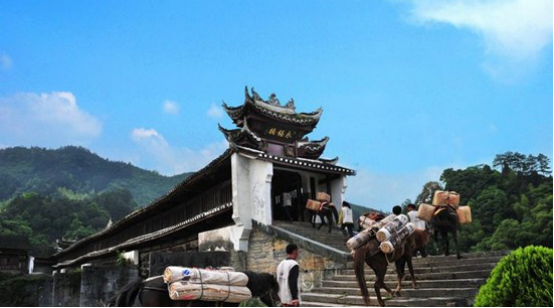文载《经济研究》2018年第10期
作者: 龙登高,王正华,伊巍
内容提要:本文聚焦于清代民间公共设施建设的组织者桥会与义渡,系统考察中国本土渊源的公益法人制度及其治理模式,揭示传统时代法人产权的属性与特征。桥会、义渡是一种非营利性、非政府性的公益机构,其理事会由民间自主推选,自愿担当,负责筹资、兴建、长期维护与运营,管理公开透明,并能完成跨区域协调工作及处理纠纷。它们拥有田地、会金等独立资产,其排他性的法人产权得到政府和法律的保障。这种法人产权形态也是民间广泛存在的家族、寺庙、善堂、书院及各种会社多样化发展的制度基础,显示了传统社会民间的动员能力、组织能力与制度创造力。它们也成为政府联结民间的纽带与中介,在基层秩序中有效地发挥着独特的作用。
关键词:公共设施 法人产权 民间组织 治理结构 基层秩序
论文梗概:
传统时代基层重大公共工程与基础设施普遍由民间承担,而且像义渡与风雨廊桥等通常以公益的形式建造,并提供免费服务。本文全面论述了民间公共设施建设的组织模式治理结构,首次论证了中国历史上的法人产权形态,并由此系统性考察了各种民间自组织的产权基础,以期推进对传统基层社会特征的反思与认识。
其一,公共设施建设形成了较为成熟的组织机构与治理结构,理事会由民间自发推选,负责募集资金、桥梁与义渡的兴建及长期维护与运营,管理公开透明,并能完成跨江河两岸甚至跨州县的协调工作,连接官府及处理外部纠纷。
其二,桥会、义渡是一种非营利性、非政府性的公益机构,在短缺经济时代的动员能力、组织能力反映了民间的制度创造力。从道德的角度很可贵,但相比较以利润为驱动力的公司等市场主体,也有其内在局限。
其三,它们拥有独立的财产,特别是具有未来增值收益的田产与基金(会金),以供长期运营。法人产权具有排他性,具有整体性和不可分割性,并得到政府和法律的保障。
法人产权不仅存在于桥会、义渡,也广泛存在于水利会(闸会)、工商业会馆、行会,及秘密会社,更普遍存在于家族、寺庙、书院及慈善救济机构中,成为凡此民间组织独立和可持续发展的基石。
其四,这些民间自组织在基层经济与社会生活的各层面中多维度地发挥各自的作用,并成为政府连接、沟通和协调基层的中介与桥梁,也成为大一统政权低成本维系基层统治的制度基础。

风雨廊桥:湖南安化永锡桥
传统中国基层各种事务多由民间自我管理,并自发形成秩序与制度,其历史遗产带来启示。
第一,中国人缺乏自组织能力,这是一种认识误区与偏见,事实上,中国基层社会具有朴素民主的传统,理事会通常由民众自主推选,自愿担当,形成了相应的较为成熟的制度安排。
第二,这些民间组织拥有自己的财产,并且产权明晰,未来收益得到保障,因此具有独立性,可以不依赖于强权而存在与发展。
第三,它们形成有效的组织体系与治理结构,运行公开透明,向社会与利益相关各方负责,有明确的章程与制度保障,能够走上可持续发展之路。
第四,有效的激励机制与约束机制,不仅与其经济利益直接相关,而且与当时的宗教、伦理与道德相配合,理事甘心付出,倾情投入,雇员努力工作,同时严格的条例与民众的监督约束他们无法也不能中饱私囊或消极怠工,有效地克服了寻租与腐败现象。
简言之,独立的法人产权,明确的章程与规则,有效的治理结构,公开透明的运作,社会与经济利益的激励,民众的监督与约束,凡此构成传统中国民间组织的制度安排,富有成效,富有启迪。
Traditional non-government organization governance structure and Institutional legal property right
--- focus on the construction and management of the public facilities in Qing dynasty
Denggao Long, Zhenghua Wang, and Wei Yi
Summary: In traditional China, local infrastructure is generally organized by the people themselves, while Yidu(charity river crossing) and Fengyulangqiao (covered bridge) and other similar projects are usually set up by public interests and provide free services. This paper comprehensively discusses the organizational model and governance structure of public facilities construction, demonstrates the legal property right form for the first time in Chinese history, and systematically investigates the property right foundation of various NGOs in order to promote the reflection and understanding of traditional grassroots society.
First, public facilities construction formed a relatively mature organization and governance structure, The council members are from the squire as voluntarily, or selected by people, and is responsible for the financing, construction, operation and maintenance. Its administration and management are open and transparent, capable for achieving cross-regional coordination and handling of disputes.
Secondly, the Qiaohui and Yidu is a non-profit, non-government public interest organization. In the time of economy shortage, the ability to mobilize and organize reflects the creativity of NGOs. From a moral point of view, it is respectable. But they have inherent limitations compared with market players, such as profit-driven companies.
Moreover, they own independent properties, mostly farmland, as well as foundations, particularly real estate property and funds with future value added earnings, which are used to run long-term operation. Their exclusive legal property right is integrity and indivisible, and are guaranteed by the government and the law.
The legal property right exists not only in the Qiaohui and yidu, but also widely exists in the Zhahui (water conservancy association), chamber of industry and commerce, association, guild, and secret society, even more commonly exists in the Clans, temples, academy and charity relief organization, and becomes independent foundations and sustainable non-governmental organizations.
The last, but not the least, these NGOs play their respective roles in various aspects of grassroots economic and social life, and as an intermediary and bridge for the government to connect, communicate and coordinate grassroots, as well as the institutional foundation for the low-cost maintenance of the unified regime.
Keywords: public facilities, legal property right, NGO, governance structure, order at the grassroots level